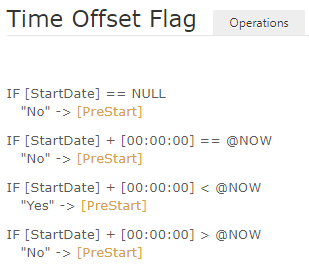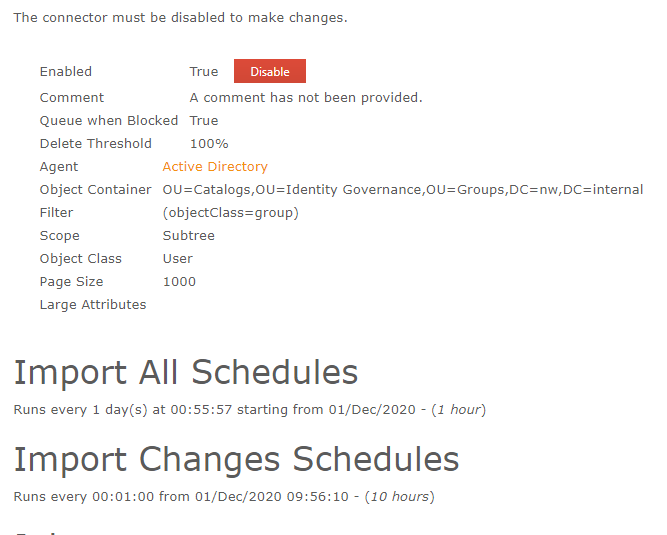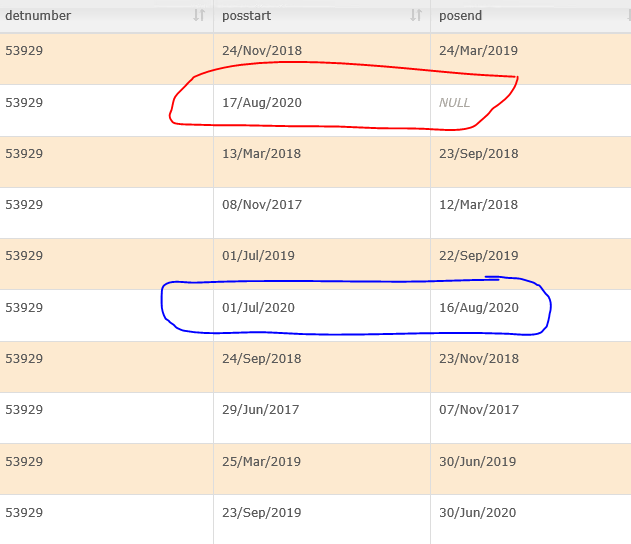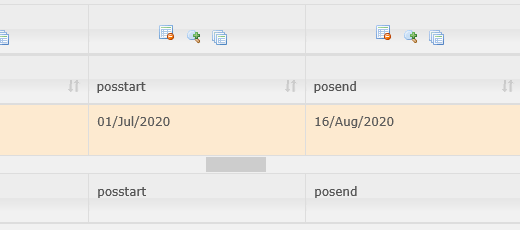Identity Broker Forum
Welcome to the community forum for Identity Broker.
Browse the knowledge base, ask questions directly to the product group, or leverage the community to get answers. Leave ideas for new features and vote for the features or bug fixes you want most.

 Time Offset Flag description in UNIFYBroker doesn't match the implementation or the voice documentation
Time Offset Flag description in UNIFYBroker doesn't match the implementation or the voice documentation
On the Edit Timeoffset Flag page in the UNIFYBroker UI, the description says:

In particular, "The target value is populated based on whether the current time is less than, equal to or greater than the offset value".
The Voice documentation (https://voice.unifysolutions.net/en/knowledge-bases/7/articles/2888-time-offset-flag-transformation) says:

An actual configuration appears like this in the UI:

When this transform was evaluated on 15/12/2020 for a value of StartDate="03/Feb/2020" the value to which PreStart was set was "Yes".
This matches the UI configuration, and the Voice documentation (i.e. source time compared to NOW - with the source time offset implied). However, it does not match the description in the "Edit Timeoffset Flag" UI (i.e. NOW compared to the offset value - with "offset value" presumably meaning "source time plus offset"). The "Edit Timeoffset Flag" UI description is reversed compared to those others and therefore misleading.

This has been implemented and is available in the release of UNIFYConnect V6, which will be made available shortly.

 Allow $logger component to specify module and submodule fields
Allow $logger component to specify module and submodule fields
There is no documented way to set the third and fourth fields (which I will call 'module' and 'submodule') of each UNIFYBroker log entry when calling the $logger component. It would be nice to be able to set them to more informative values, rather than always having them as 'UNIFYBroker' and 'PowerShellTask' respectively.

Hi Adrian,
The $logger component is designed to be a simple wrapper around the logging mechanism. For more complex log messages, use the $messageService variable.
There's some extension methods provided for the next level of logging. You can find more information on those here:
Class NotificationEnumerableExtensions (unifysolutions.net)
Otherwise, you can use the underlying NotificationMessageService to notify listeners of a particular message. In this case, the product loggers will be listening on ILogEntryNotification: Class LogEntryNotification (unifysolutions.net)
The tricky thing with crafting one of these will be building the branding object, (for a BrandedLogEntry). Technically this would allow you to change both the 'module' and 'submodule' components.
For ease of use, i'd recommend just using the NotificationEnumerableExtensions to log - which still use the underlying product for the third field but allow you to define the fourth field.
As a side note, for some reason the $messageService variable isn't actually hooked up for the Plus components, but is hooked up for the Powershell connector and transformations.

 Next run times don't look right for newly added connector schedules
Next run times don't look right for newly added connector schedules
It's ~9:30am and I just added and enabled an Import All and Import Changes schedule to a connector. The Import All I set to run at 12:55:57am, and the Import Changes every 1 minute. The following appeared, which doesn't look right - 1am isn't an hour away, and one minute is not 10 hours away:


Hi Adrian,
The scheduled times are displayed in the local time of the machine. In this case, the containers are running on UTC. So with the UTC time (at time of screenshot) being 11pm on 30 November, that looks accurate.

 Re-order Connectors and Adapters
Re-order Connectors and Adapters
In UNIFYBroker we could edit the connector and adapter extensibility files to re-order the connectors and adapters in the web UI. Could you please add a facility to do this in UNIFYConnect?

 Join with Sliding Window with Most Relevant doesn't match record with NULL end date
Join with Sliding Window with Most Relevant doesn't match record with NULL end date
UNIFYBroker v5.3.2 with Chris21.
Chris21 Person adapter is configured with a Join transformation to a Chris21 placement connector with a Sliding Window and type Relevant. A placement with a start date in the past and a NULL end date is not being selected (a NULL end date means ongoing placement, with no scheduled end date). Instead, the most recent placement with a non-NULL end date is selected.
Here is the placement data:

Here is the configuration:

The transformed adapter data shows an incorrect posstart and posend (and all other selected attributes):

This problem did not occur in Identity Broker v4.
It may also be relevant to note that the 'First' or 'Priority Selection' radio box does not appear for the Relevant type. It used to appear for this transform and type in Identity Broker v4.

Hi Beau, sorry I thought I'd already responded to this. The problem was just a handful of records and Generate Changes cleared it. Please close this ticket.

 REST API endpoint for external Azure Access Request call-ins
REST API endpoint for external Azure Access Request call-ins
In this morning's MS Identity Advisors session MS provided a clear indication that they are planning to move towards a call-out model for on-demand Access Request integration with external systems. To get ahead of the curve on this, we could look at offering an extensible REST API endpoint in UNIFYBroker.
Typical usage would be:
Azure sends UNIFYBroker a request for user "bobsmith" asking UNIFYBroker for a certain attribute for that user (e.g. department number) or asking UNIFYBroker to provide an answer to a question (such as "is this user allowed to get access to resource X at the moment?") UNIFYBroker responds and Azure uses that information to approve or deny an in-flight Access Request.
My suggested solution is that the request for user "bobsmith" (and/or "resource X") would map to a adapter record lookup, and the "answer" UNIFYBroker gives back would be the value of one or more fields for that matching record.

Hi Adrian
Since v5.2, Broker has included the OData gateway, which allows adapter entities to be queried via an OData REST API, which would cover the use case in your example. That said, since it's introduction I don't believe it's seen much, if any, real usage so may not fully support the types of request and filtering features that would be expected of it. Improving the OData gateway is definitely something we're interested in for future releases, so if you have the chance to try it out your feedback would be appreciated.
Also introduced in v5.2, the SCIM gateway provides a REST API conforming to the SCIM 2 specification, a standardized data schema for transmitting identity information via JSON payloads. The primary usage of this gateway thus far has been to connect Broker with Azure AD, which operates as a SCIM client to pull and push standardized users and groups from Broker. I mention it because it does support search and filtering features that would cover your example use case, however the rigid data structure it provides may be too limiting for non-SCIM-specific scenarios.

 Difference between the Time Offset configuration in IDB 4 and IDB 5
Difference between the Time Offset configuration in IDB 4 and IDB 5
Hi Team,
In IDB 4, the Join Transformation has this configuration (see attached screenshot)

Whereas, in IDB 5 looks like this (see attached screenshot)

How come in IDB 4 its a - sign between [posstart] and time offset, whereas in IDB 5 its a + sign? What are the difference? Thank you
Regards,
Marc Laroza

Hi Marc
I believe the v4 UI was incorrect, and it was updated to reflect how the offset times are actually calculated. I don't think the actual behaviour of the transformation changed, but you should double check this to be sure.

 AD Connector ObjectSid field not working with Postgresql
AD Connector ObjectSid field not working with Postgresql
When running an import on AD Groups, the objectSid field is defined as a string on the connector schema. SQL can import this field fine (although shows as jargon on the UI). Postgres fails to import with the following error:
Connector Processing page 1 for connector On-Prem Groups failed with reason 22P05: unsupported Unicode escape sequence. Duration: 00:00:08.3359933. Error details: Npgsql.PostgresException (0x80004005): 22P05: unsupported Unicode escape sequence at Npgsql.NpgsqlConnector.<>c__DisplayClass161_0.<<readmessage>g__ReadMessageLong|0>d.MoveNext() --- End of stack trace from previous location where exception was thrown --- at System.Runtime.ExceptionServices.ExceptionDispatchInfo.Throw() at Npgsql.NpgsqlConnector.<>c__DisplayClass161_0.<<readmessage>g__ReadMessageLong|0>d.MoveNext() --- End of stack trace from previous location where exception was thrown --- at System.Runtime.ExceptionServices.ExceptionDispatchInfo.Throw() at Npgsql.NpgsqlDataReader.<nextresult>d__46.MoveNext() --- End of stack trace from previous location where exception was thrown --- at System.Runtime.ExceptionServices.ExceptionDispatchInfo.Throw() at System.Runtime.CompilerServices.TaskAwaiter.HandleNonSuccessAndDebuggerNotification(Task task) at Npgsql.NpgsqlDataReader.NextResult() at Npgsql.NpgsqlCommand.<executedbdatareader>d__100.MoveNext()</executedbdatareader></nextresult></readmessage></readmessage>
Changing the field type to 'binary' and attempting an import yields a different error at an earlier stage:
nify.Product.IdentityBroker.EntitySchemaValidationException: Invalid binary - the value was a string, but was not able to be converted as a base64 encoded string from: ??? ? ---> System.FormatException: The input is not a valid Base-64 string as it contains a non-base 64 character, more than two padding characters, or an illegal character among the padding characters. at System.Convert.FromBase64_Decode(Char* startInputPtr, Int32 inputLength, Byte* startDestPtr, Int32 destLength) at System.Convert.FromBase64CharPtr(Char* inputPtr, Int32 inputLength) at System.Convert.FromBase64String(String s) at Unify.Product.IdentityBroker.EntityBinaryTypeSchemaValidator.CreateValue(Object dataValue)

 Extensibility config lost due to full hard disk
Extensibility config lost due to full hard disk
Hi,
Recently we had an issue come up where the server ran out of disk space while writing the XML config files.
Would we be able to request a feature where the existing file is renamed to a .bak file before writing a new XML file.
If the server runs out of disk space, the file will fail to rename, preventing the mentioned issue.
Thanks

 MIM Sync Adapter integration usability improvement suggestion
MIM Sync Adapter integration usability improvement suggestion
At the UNIFYBroker site I am presently working on there are now 7 Broker-driven management agents for MIM, most of which interact with multiple adapters. I have found that it starts to get unwieldy when it a single schema change in a single connector requires a schema/interface refresh of all 7 management agents. Furthermore, when deploying MIM sync configuration and using the schema matching dialog, there is a need to deselect all of the adapters (LDAP partitions) which are not relevant to each particular MA, complicating the deployment process.
It would be great if there was a way to limit visibility of the UNIFYBroker adapter set on a per-management agent basis - and the most obvious way I could think of achieving this would be by using multiple LDAP user accounts, and extending the Settings page to support mutli-selection of adapters per LDAP user. In this way, adapters visible to any given MIM MA would be determined by the use of an appropriate user account - rather than the current practice of using the same LDAP user for every MA.
This would address both of my above scenarios as follows:
- A single connector schema change would potentially limit the need for schema refreshes to a single MA; and
- Partitions not visible to the LDAP account would no longer appear on the partition matching dialog, and in most cases this would reduce the number of partitions requiring deselection (and in many cases eliminate the partition matching dialog being displayed altogether) when importing MIM sync server config XML.
Customer support service by UserEcho

